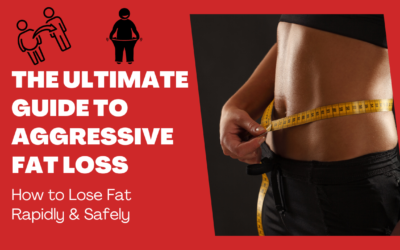How to Determine Your Calorie Deficit for Weight Loss (In Just 2 Easy Steps)

A calorie deficit isn’t merely a suggestion or a nice-to-have, it’s a scientific requirement for weight loss.
You could have the best-designed workout program in the world and eat super healthy but…
No calorie deficit = no weight loss.
If you haven’t been able to lose those 20 pounds you want, it’s because you’re not actually in a calorie deficit.
So what is it and how can you create one for yourself?
That’s what we’ll be going over in this post, how to calculate your calorie deficit for weight loss so the scale starts trending in the right direction.
What is a calorie deficit for weight loss?
Being in a calorie deficit means consuming fewer calories than you burn.
A calorie deficit falls in line with the whole “calories in vs. calories out” principle.
If you eat fewer calories than your body needs, you’ll lose weight.
On the flip side, eating more calories than your body burns will lead to weight gain (but with a solid strength training plan that prioritizes compound lifts and progressive overload, most of that weight gain will be muscle).
Remember those brainstorming charts you made in school as a kid?
You can think of a calorie deficit like that
Obviously, the central theme in the middle is would be a calorie deficit but there are different subcategories that feed into it.
You have cardio (or daily movement), which, simply getting somewhere between 7.5K-10K steps every single day is one of the easiest ways to boost your metabolism.
You have getting enough sleep and stress management, both of which are key to controlling hunger.
There’s also strength training, which enables you to build/retain muscle mass to give your physique a more defined and fit look, as opposed to a skinny fat body (you’re not overweight but any stretch but your body looks soft, unfit, and a little flabby).
And I’ve saved the best, most important piece for last…
Your nutrition.
How much you’re eating is the overwhelmingly most crucial factor when it comes to creating a calorie deficit for weight loss.
Think of your diet as the foundation of your weight loss house.
If your nutrition (foundation) isn’t in order, the entire house will crumble.
So the focus on creating a calorie deficit for weight loss should be on the number of calories you’re eating.
Think you can out-exercise a poor diet?
I promise you, it would be a complete waste of your time to even try.
How many calories should you eat to lose weight?
2 +2 = 4.
That’s something we all know, right?
Hopefully…😅
Well, figuring out your calorie deficit for weight loss is just as simple.
Below, I’ll show you how to do it in just two easy steps.
1. Figure out your maintenance calories
The first step in determining your calorie deficit for weight loss is figuring out your maintenance calories.
These are the calories that, if you ate them, would allow you to maintain your current weight.
Use this calorie calculator.
Just put in all your info (age, weight, height, activity level) and click “Calculate!”
2. Take 80% of your maintenance
Once you have your maintenance calorie number, simply take 80% of that to get your calorie deficit for weight loss.
For example, if your maintenance is 2,500, your deficit calories would be 2,000 (2,500 x 0.8 = 2,000).
That’s all it takes.
Just two simple and straightforward steps to figuring out your calorie deficit for weight loss.
Calorie deficit for weight loss example
Let’s run through a quick calorie deficit example just to make sure everything makes sense to you.
Stats for our example person:
- Gender: Male
- Age: 28
- Weight: 200 lbs
- Height: 6ft
- Activity: Moderate Exercise (3-5 times a week)
1. Get your maintenance calories
After inputting all the information for our example person, you should get 2,969 for maintenance calories.
2. Take 80% of your maintenance
Taking 80% of our example person’s maintenance, you’d get a calorie deficit for weight loss of 2,375 (2,969 x 0.8 = 2,375).
How to track your nutrition in a calorie deficit
You have the number of calories you need to eat for weight loss but that number won’t do you any good unless you actually keep track of it.
That’s where counting calories comes in.
Before you tell me why calorie counting is too much work….
You know what’s even more work?
Not counting calories and being stuck in the same position 6 months from now, frustrated and wondering why you’re not losing any weight.
Refusing to count calories would be like trying to get to a place you’ve never been before without a GPS or a map (you’d get lost).
In the same way, if you don’t know how much you’re eating, you’ll be lost as to whether or not you’re actually in a calorie deficit for weight loss.
Counting calories gives you a road map to ensure you’re eating the correct amount that will lead to weight loss.
Can you lose weight without counting calories?
Yes, you can.
Being in a calorie deficit doesn’t hinge on whether or not you count calories.
But I highly, highly, highly encourage you to try it for at least a few months so you can learn about portion sizes and what makes up certain foods (i.e. the protein, carb, and fat content).
Once you gain some experience with that, you can graduate to eating more intuitively.
Just starting out though, count your calories.
You’ll make fat loss a lot easier for yourself.
How much of a calorie deficit is too much?
You might be thinking to yourself:
I can just skip all this and slash my calories down super low so I’ll lose a lot of weight fast…
Get off that 1,200-calorie crash diet train.
Fast and sustainability are polar opposites when it comes to being in a calorie deficit for weight loss.
So start thinking about how to be consistent and what’s sustainable, as opposed to what’s quick.
What kinds of foods should you eat in a calorie deficit?
I go into a lot more detail about what to eat in a calorie deficit in this post but just as a little teaser, here are some foods you’ll definitely want to prioritize within your diet:
- Protein: Protein is king for maintaining a calorie deficit. It reduces hunger hormones in your body and increases hormones that make you feel full, it boosts your metabolism, and it’s crucial to building lean muscle mass.
- Foods that are high in fiber: Similar to protein, fiber is super filling. It’s also insanely beneficial for your health (reduces your risk of heart disease, among other things). Berries (blackberries, blueberries, raspberries), whole grains, and chia seeds are just a few examples of foods high in fiber.
- High-volume foods: These are foods that give you a lot of bang for your calorie buck (i.e. you get to eat a lot of them for the number of calories they contain). Leafy greens (or really, just vegetables in general) and fruits like watermelon are a couple of examples.
By the way, you can use this weight loss grocery list I made so you’re not wandering around like a lost puppy on your next trip to the store.
Calorie deficit for weight loss FAQs
What is a good calorie deficit for weight loss?
Your calorie deficit will be different from the next person’s.
You can go back through the two simple steps we covered to determine yours:
- Find your maintenance calories
- Take 80% of that number
^^^ That will give you your calorie deficit for weight loss.
Can you lose fat just by being in a calorie deficit?
Being in a calorie deficit is THE ONLY WAY to lose fat.
If you are not losing fat then you’re not in a calorie deficit.
There are a variety of reasons as to why this might be, you not truly being in a calorie deficit.
How many calories are needed to lose 1 pound of fat?
There are roughly 3,500 calories in one pound of fat.
So in theory, you would need a weekly deficit of that much to lose one pound of fat a week.
But that’s not how things work.
Weight loss isn’t linear and the scale will jump all over the place for a variety of reasons, even if you’re doing everything right.
Should I go on a calorie deficit to lose belly fat?
If your goal is to lose stubborn belly fat then, yes, you do need to be in a calorie deficit.
But just know you can’t target fat loss in specific areas of your body.
Your genetics will dictate where you lose fat first.

What's up?
I’m Chad, I’m happy you’re here! I’m a certified personal trainer and my goal is to help you form practical, sustainable habits that lead to lifelong fitness results. If you want to lose fat, build muscle, and live a healthier, happier life then you’re right where you need to be. 💪🏾
Free resources
⬇⬇⬇










0 Comments